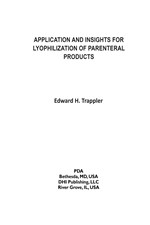Application and Insights for Lyophilization of Parenteral Products (single user digital version)
- Format
- PDF Single user
- Member Price
- $55.00
- Nonmember Price
- $69.00
- Government Price
- $30.00
Please sign in or become a member to purchase items from the PDA bookstore.
This chapter is taken from the book Practical Aseptic Processing: Fill and Finish, Volume 1
Lyophilization has been used since the mid 1930s (Flosdorf et al., 1938) with the intent of preserving health care products that
are not stable in a liquid ready-to-use form in the presence of water. The limited stability is due to degradation involving hydrolysis reactions with water.
Preservation for adequate long term storage for such parenteral products is achieved by converting the product from the liquid to the dried state. In preparation of a solid sterile product for administration to a patient, a diluent, often water for Injection (WFI), is added to return the product to a liquid, suitable for parenteral administration. Though the application of this technology was first applied to plasma and antibiotic parenteral products, lyophilized parenterals continue to include antibiotics, human derived plasma products, vaccines, now encompassing entities such as recombinant proteins, liposomes and nanoparticles.
The scientific basis of this technology is rooted in fundamental principles of basic chemistry and biochemistry, physics and the applied physical sciences. This presentation on the subject is designed to provide an overview of the unique aspects and principles applied to producing diverse types of parenteral products.
Available to download. Prior to purchase please view the download instructions and Terms of Usage.
Format: Digital PDF (1 file - 3.20 MB)
Table of Contents
Table of Contents:
About the Authors
About the Authors
Edward H.
Trappler is founder and president of Lyophilization Technology, Inc. a
contract research, technical services and clinical material manufacturing firm
dedicated to freeze drying. He has over 30 years experience in lyophilization
that ranges from product development to equipment application engineering. He
received his Bachelor of Science degree in chemistry at The College of New
Jersey. His experience in the pharmaceutical industry includes product
development, toxicology supply preparation, clinical manufacturing and
parenteral production. Ed has authored and presented numerous papers and courses
in freeze drying in the United States, Europe, Japan and China. He is an active
member of the PDA, serving on a number of committees, including as chairperson
of the Lyophilization Validation Task Force. He is also a member of the American
Association of Pharmaceutical Scientists, American Institute of Chemical
Engineering, and International Society of Pharmaceutical Engineers.

